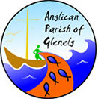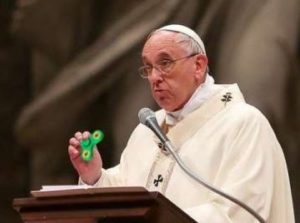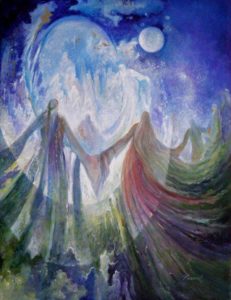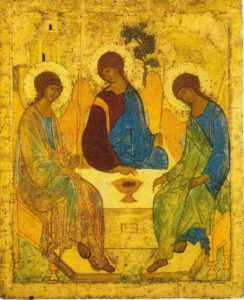God’s Relationship With Us
Trinity Sunday Year C 2019
preached by Ven Andrew Mintern
Parish Priest and Archdeacon of Torrens
Introduction – The Fidget Spinner Trinity
Did Pope Francis know the theological debate he would stir up when, in 2017, he used a fidget spinner to describe God as Trinity. You can read all sorts of theological critiques of this on the internet. Yes it’s a limited image, but what it is does have in its favour is that it’s fun! Also it was relevant (at least it was during the height of the fidget spinner craze) but especially because the fidget spinner has movement and energy and I think that’s great because so does God.
Trinity Sunday ‘s Place in the Liturgical Year
Today on Trinity Sunday we arrive at a momentous final statement in a great liturgical drama that began at the start of our liturgical year with the first Sunday of Advent. Following the promise of the coming Christ, we celebrated Christ’s incarnation at Christmas; his revelation to the Jews (in the shepherds) and to the whole world (with the magi) celebrated in the season of Epiphany. We marked Jesus’ baptism, his temptation in the wilderness, which we emulated in the forty days of Lent where through fasting, prayer and charity as we prepared to celebrate holy week, that most pivotal week in the Christian story. During Holy Week we traced Jesus’ journey from Palm Sunday with the triumphal entry into Jerusalem, to the overturning of tables in the temple, to Maundy Thursday and the last supper, the sharing of bread and wine, the washing of the disciples feet in an example of servant leadership followed by his arrest. On Good Friday we prayed before the cross of Jesus’ crucifixion and on Easter morning rejoiced at the empty tomb and the good news of resurrection. Since Easter we have heard many of the resurrection appearance narratives and the impact those experiences had on the disciples. We marked the time when those resurrection appearances ceased with the feast of the Ascension and then last week we commemorated the coming of the Holy Spirit, the birth of the church at Pentecost and the good news spoken in many languages spreading to the whole world. Jesus’ disciples were inspired and empowered to continue to follow him and spread the good news of God’s gifts of love and eternal life.
Trinity Sunday today marks the day to celebrate in awe and wonder that most unique Christian belief in the nature of God, encapsulating all that we have learnt on this worship journey and setting us towards the remainder of the liturgical year, into the season of what was once called Sundays after Trinity, and then Ordinary Sundays and now Sundays after Pentecost. By the way, all those titles are relevant. We live as a church in the power of the Spirit which is emphasized by calling them Sundays after Pentecost, the meaning of Ordinary Sundays is lost by the more common understanding of ordinary as “normal” or “nothing special”, but the word Ordinary means according to rule and authority, and so it refers to the Sundays following the rule of liturgical readings. Personally and somewhat eccentrically, I prefer the phrase “Sundays after Trinity” because of through our experience of Christ and the gifts of the Spirit we live always in the faith and understanding of God as Trinity.
Trinitarian expressions in our Worship
Now many people get hung up in talking about the Trinity and feel it’s just a load of theological philosophical jargon. But have a look at our worship.
- Starting at the greeting – The Grace of the Lord Jesus Christ the love of God and the fellowship of the Holy Spirit.
- The prayer of preparation – Almighty God… inspiration of the Holy Spirit… through Christ our Lord
- The three parts of the Gloria
- The three parts of the Creed
- The threefold pattern of the Eucharistic prayer
- The sending out prayer – Father we offer ourselves as a living sacrifice through Jesus Christ our lord, send us out in the power of your spirit….
- The threefold Trinitarian patterns of most of the blessings we use.
The language of Trinity is saturated throughout our liturgy. It becomes second nature to us in how we speak of God and worship God.
Triadic Formulae from Church History
Many people (theologians, saints and writers) throughout history have used images or triadic formulae to try to capture the reality of the Trinity –
- Father, Son and Holy Spirit (is the best known but there are more)
- Creator, Redeemer and Sanctifier,
- Earth-maker, Pain-bearer, Life-giver
- Abba, Servant, Paraclete,
- Creator, Christ and Spirit
- Maker, Keeper and Lover
- Mother, Lover and Friend
- Power, Wisdom and Love
- Speaker, Word and Breath
What all of these formulae point to is the enormous mystery of God, and the limitations of Human language to capture that enormity. All of the formulae have merit and limitations (just like the fidget spinner analogy has strengths and weaknesses) but put all those formula and images together and they enrich our faith.
Trinity as Relationship
I think it is the language of relationship that helps us most in capturing the nature and activity of God in our world and in our lives. St Augustine said: “[the three divine persons] are each in each and all in each, and each in all and all in all, and all are one” (De Trinitate 6, 12). There is an intimacy of relationship there that is beautifully captured by a piece of theology that transcends into poetry. And yet, it only speaks of what is happening within Godself.
In the 7th Century John of Damascus used the image of Perichoresis , the divine dance, to speak of God’s relationship. It is an image that engages us, seeing that God is movement, as the Pope tried to show with the fidget spinner. But where the fidget spinner is a self- contained object, the divine dance is one that we can participate in. Like the image on the front of the pew sheet a painting called perichoresis, it clearly shows that we are swept up into God’s dance within creation and history. It is participatory. We are not separate from God’s life but drawn into its eternal movement.
In similar vein, Andrei Rublev’s famous icon, whilst a more static image, very clearly shows an open space at the table where the Trinity are seated. The faithful viewer who prays before the icon is invited in and drawn into the company of God, taking their place at the holy table.
Conclusion – God’s Relationship WITH us.
In the end, the language we use for God is always inadequate. Perhaps the most important thing we can say are those words from St John, God is love. Love is always best known in relationship.
We see the divine relationship of the Trinity at work in the life, death and resurrection of Jesus.
We see the divine relationship of the Trinity in the beauty of the world.
We see the divine relationship of the Trinity in the inspiration and power of the spirit.
We are caught up into this divine relationship of love.
We are saved within the power of this relationship.
So the Trinity is not only God’s relationship – it is God’s relationship with us.
Amen.



